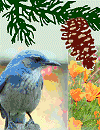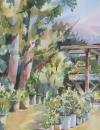Butterfly gardeners begin this way….they see a colorful butterfly in their garden and start paying attention. They want to see more so they wait and observe during the spring and summer. How can they see more kinds, they wonder. That’s how I began, I’m sure.
Once you begin observing, you notice more and more about these beautiful creatures. Everyone knows they drink nectar from flowers, but what kind of plants will attract them. Is it possible to plant the right kind of plants that would fill your garden with these ‘living leaves?’
Wild flowers, cultivated flowers (perennials and annuals) and even some shrubs are a fantastic start. Lilac bushes, blueberry bushes, grasses, abelia, butterfly weed, chrysanthemums, daises, purple coneflower, buddleias, black-eyed Susan, , goldenrods and verbena are all flowers and shrubs that will attract butterflies for your observation to your garden.
Butterflies in our Sierra Foothills include, Swallowtails, Buckeyes, Skippers and California Sisters and many more. If you’ve seen a butterfly in Central California that you’d like to identify, try Art Shaprio’s Butterfly Site., associated with UCDavis. Calphotos is another place where you can browse through many California butterflies.
Try these when designing a butterfly garden bed:
Tall
Buddleia davidii (Butterfly Bush)
Eupatorium purpureum (Joe-pye weed)
Medium-tall
Pennisetum setaceum (Purple Fountain Grass)
Asclepias tuberosa – Butterfly Weed
Kniphofia spp. – Red Hot Poker
Aster novae-angiae (New England aster)
Monarda (Bee Balm )
Asiatic Lily Rudbeckia hirta (Black-eyed Susan)
Echinacea purpurea (Purple Coneflower)
Liatris spicata (Blazing star)
Medium
Veronica spicata ‘Sunny Border Blue’
Coreopsis verticillata (Tickseed)
Gaillardia (Blanket flower)
Solidago canadensis (Goldenrod)
Agastache x ‘Ava’ (Hummingbird Mint)
Sedum Stonecrop ‘Autumn Joy’
Low
Scabiosa (Pin Cushion Flower)
Glandularia canadensis (Rose Verbena)
California foothill natives that attract butterflies
Arctostaphylos, Manzanita
Lonicera interrupta, Chaparral Honeysuckle
Lupinus albifrons, Silver Bush Lupine
Madia elegans, Elegant Tarweed
Muhlenbergia, rigens Deer Grass
Rudbeckia hirta, Black-eyed Susan
Wyethia elata, Hall’s Mule’s ears










 WesternSierra Nursery-Oakhurst, CA
WesternSierra Nursery-Oakhurst, CA Dave's Garden Plant search
Dave's Garden Plant search Intermountain Nursery-Prather, CA
Intermountain Nursery-Prather, CA






i’m at bass lake – can i grow blueberries here? rnjoy your lovely blog!
Hi Patti, yes, you sure can grow blueberries! They grow a lot in Maine where it is as cold as we have it here. Blueberries are in the same family as azaleas and rhododendrons, and need similar growing conditions. For more info see this link from UCDavis, geared more for farms but having lots of useful instructions. http://sfp.ucdavis.edu/pubs/brochures/blueberries.html
Robbie’s Nursery in Bakersfield always had Gulf Fritillary butterflies flittering around their passionflower vine, so I bought a plant from them. Each year, the Gulf Fritillaries appear in my back yard as if by magic. Of course, their caterpillars eat the vine to nubbins by the end of the season, but that is the whole point of the vine. The passionfower vine is the host plant for the caterpillars. No caterpillars, no butterflies. To add to the display, last fall I got 5 caterpillars from the Insect Lore Bugseum in Shafter, CA and this spring a bunch of Painted Ladies hatched out and were sipping the asters and sages. So the moral of the story is, plant it and they will come, especially with a little help.
All good information, Monica,…it’s so nice to hear of your experience! Sounds like what you did worked just fine. :-)
Wonderful post, Sue! I know that butterflies are naturally attracted to a lot of our Cal natives, which we’ve got plenty of, but on a whim, I started experimenting with other non-native varieties last year in a small area next to the olive grove primarily to attract hummingbirds and butterflies. Your list of suggested plants is very, very helpful. So far, I’ve got several different varieties of autumn sages, agastaches, asclepias, rudbeckias, gaillardias and monardas (bee balms) in the ground, along with two varieties of Caryopteris clandonensis (‘Dark Knight’ and ‘Longwood Blue’) -both which quite small right now, but should eventually grow into medium 4′ shrubs with light blue blooms that are highly attractive to butterflies. I love butterfly bushes and have one, a magenta-flowered B. davidii, growing at the front of the house. They can get quite large though, at 8’+ in height, so I need to find a more dwarf selection to fit into the butterfly garden’s smaller space. As always, I really enjoy all the photos of your beautiful plants, great plant combinations and gorgeous garden views!
Natives and non natives….I love all the ones that attract butterflies, like you, Arleen! I have recently discovered agastache, and although, I can’t figure out the pronouciation, I certainly can say ‘hummingbird mint’. LOL! I also have a Caryopteris ‘Dark Knight’ which I haven’t seen blooming yet, but maybe it’s big enough this year. I wish asclepias or milkweed was available in nurseries near me. I haven’t had luck sowing seeds here yet. Thanks so much, Arleen.